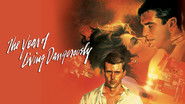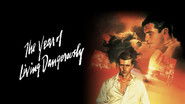Lovesusti
The Worst Film Ever
Unlimitedia
Sick Product of a Sick System
Console
best movie i've ever seen.
Arianna Moses
Let me be very fair here, this is not the best movie in my opinion. But, this movie is fun, it has purpose and is very enjoyable to watch.
martharay-01256
Gorgeously filmed and aided by some excellent performances Peter Weir has made a great film in The Year of Living Dangerously. Mel Gibson plays a young Australian reporter stationed in Jakarta, Indonesia under the Sukarno regime. He befriends a dwarf Chinese- Australian named Billy Kwan and romances a Brit journalist Jill Bryant. The look of the film is good- It makes it seem almost akin to a documentary and there is a beautiful glow to each scene. All the actors are in top form- Gibson, Sigourney Weaver and especially Linda Hunt who plays the dwarf. This is a sweeping tale of morality, romance and political unrest. Another highlight is the score by the ever-reliable Vangelis.
joemccoy-72932
Peter Weir's The year of living dangerously is a fantastic film. A fictionalized story based on real world happenings it is drama and romance interwoven against a political backdrop. Both the leads Mel Gibson and Sigourney Weaver are stunning (in my opinion one of the best movie couples ever committed on film) and Linda Hunt is amazing as the male dwarf (she won an Oscar for her work here). Vangelis has provided a sublime soundtrack, and even by his lofty standards I hold it on a higher level than his other work. Of course the architect of the entire project- The director Peter Weir skillfully directs his actors in various locations around the Indonesian islands and this is a testimony of how underrated the man is(seriously where is his lifetime achievement?) . He has made poetry in motion here.
JohnHowardReid
NOTES: Linda Hunt won the Best Supporting Actress Awards from the Academy of Motion Picture Arts and Sciences, the Australian Film Institute, the Boston Society of Film Critics, the Los Angeles Film Critics Association, the National Board of Review, and the New York Film Critics. She also won the Australian Film Institute Jury Award. The movie also received nominations for AFI Awards in the following categories: Best Film, Best Director, Best Screenplay, Best Cinematography, Best Art Direction, Best Film Editing, Best Music Score, Best Costumes, Best Actor (Mel Gibson), and Best Sound. Negative cost: $6 million.MGM's claim that this movie was the first Australian film to be financed by a U.S. company is, of course, absolute rubbish. Rangle River (1936) was the first Oz movie to be financed entirely by a Hollywood company (Columbia), though U.S. companies did invest in previous Australian movies such as Get-Rich-Quick Wallingford (1915) starring Fred Niblo, and Venus of the South Seas (1924) starring Annette Kellerman. In the sound period, Universal invested in A Ticket in Tatts (1934) and at least six or seven other films during the 1930s. The important film in this decade, however, is the previously mentioned Rangle River (1936) which received an enormous amount of local publicity. During the 1940s only Smithy (1946) (Columbia) was wholly financed by Hollywood. In the following decades of the 1950s and 1960s, a number of Australian films were partly financed by Hollywood companies, but only ten were made with 100% Hollywood money: The Kangaroo Kid (1950) (Embassy), Kangaroo (1951) (20th Century-Fox), Long John Silver (1954) (Joseph Kaufman/20th Century-Fox), Smiley (1956) and its sequel, Smiley Gets a Gun (1958) (both 20th Century-Fox), On the Beach (1959) (Stanley Kramer/United Artists), Summer of the 17th Doll (1959) (Hecht-Hill- Lancaster/United Artists), The Sundowners (1960) (Warner Bros.), Port of Escape (1961) (John Calvert), Color Me Dead (1968) (Commonwealth United/Metro-Goldwyn-Mayer). Of course a number of Oz movies of the 40s, 50s and 60s were wholly financed by British studios, but that is another story, though I should mention The Shiralee (1957), wholly financed by Ealing/MGM British! The moral of this survey is: Though always strong on hyperbole, MGM's publicity department was occasionally light on facts.COMMENT: Anyone expecting an atmospheric vision and pictorially imaginative exposition of South-East Asia is going to be a bit disappointed. True, there are some great scenes, but with one or two exceptions the pictorial richness of "Picnic at Hanging Rock" is missing and a lot of the time it is composer Maurice Jarre rather than the director (or the photographer) who is working hard to convey atmosphere and dramatic impact. Instead Weir has opted to concentrate a lot of his attention on his characters. Unfortunately they are not a particularly interesting lot. Perhaps with a different cast, something dramatic, something expressive of the tension and conflict expressed in some of the dialogue and situations might have come across despite the unhelpful hand of the director. But with players like Mel Gibson, Noel Ferrier, the dwarf, and even normally reliable people like Michael Murphy, the battle for our attention is lost. Because the characters are so uninteresting, the film seems much longer than it is and there is little drama and atmosphere despite the sometimes well-filled CinemaScope screen of milling crowds and agitated mobs.
sharky_55
Weir's fascination with the mystical and magical has taken him to places where most filmmakers would never dare to venture for fear of obscuring or losing the audience. He is Australian and maintains that connection through many of his films, but has also stepped out of this comfort zone and into the international; away from the cultural cringe and tall poppy syndrome that raided our media and arts for so long and I think still to an extent does so. Weir is a good choice, perhaps not just for the geographical proximity of Australia to Indonesia and how he understands how to use the landscape as a way of building character (see The Last Wave), but also for the way in which the expatriate stumbles in his navigation of the new environment, buffeted by the cultural shift and on permanent unease and wariness. We sense this is something that Weir is quite familiar with. A young Gibson is therefore perfect for the role of Guy Hamilton; an immature, fresh-faced reporter thrust into a role a great deal more important than himself, he has that vitality and zest that you cannot get with an older portrayal. Most people have gone through the same period - the one in which your future aspirations aim higher than the clouds and you feel ready to change the world. Guy is rough on the edges and easily distracted when he sees the white jewel in a murky, foreign forest, but initially, perhaps, he has those qualities. To the extent that he maintains them is where we lose track a little, but he shows enough promise to be taken under the wing by the local veteran, Billy Kwan, diminutive in stature but not in courage. Linda Hunt's portrayal has been praised widely and deservedly - she in herself has created so many layers of sexual ambiguity and mystery that aren't explored, and ultimately the character is reduced to a rather pointless sacrificial lamb (she dies for a tiny, insignificant cause which leads nowhere except to highlight the moral danger that is all around this politically charged country), but she has done more than enough to keep us guessing long after her demise. Kwan is an extension of Weir's mystical; less person or dwarf, and more a creature of great passion and emotional capability that feels a sense of moral debt to those around him and goes to great lengths to pay it off. She is almost positioned on another layer from the narrative itself at times; the cryptic voice-over revisiting its own plans and devices and muttering on the happenings and progress of these...like a guide that introduces you to a strange, new world at the beginning of a video game only to chastise and take back its godlike power when you stray down the wrong path or kill the wrong targets. But the message itself seems contradictory. Kwan bestows great responsibility and opportunity onto Guy - including positioning him with a make or break story that could potentially save many lives. But he also criticises him for his nobler intentions; he would give up the whole world for Jill, he claims, and has mistakenly thought that Guy too would do the same. Eventually he does go along those lines. After a rather tame rise to the challenge that rewards him with a busted eye, he rationalises that his love for Jill is more important and scurries away. Is it wrong to expect more of a character in this situation? The film poses so many questions of its political environment but shys away from answering all but the trivial ones. Weir's vision is limited by its caricatures, and in the end the noble white man has not even risen to the challenge, but run away from it (hand in hand with the fair maiden). And Weir, incredulously, frames this as an epiphany, as a coming to the senses.





